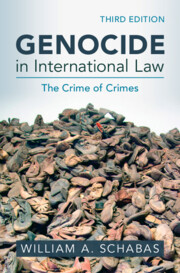Book contents
- Genocide in International Law
- Genocide in International Law
- Copyright page
- Dedication
- Contents
- Preface to the First Edition
- Acknowledgements
- Abbreviations
- Introduction
- 1 Origins of the Legal Prohibition of Genocide
- 2 Drafting of the Genocide Convention
- 3 Subsequent Normative Developments
- 4 Groups Protected by the Convention
- 5 The Specific Intent to Commit Genocide
- 6 Punishable Acts of Genocide
- 7 Cultural Genocide, Ethnic Cleansing and Other Acts Not Punishable under the Convention
- 8 ‘Other Acts’ of Genocide
- 9 Defences to Genocide
- 10 The Duty to Punish Genocide
- 11 Prosecution of Genocide by International Criminal Tribunals
- 12 State Responsibility and the Role of the International Court of Justice
- 13 Prevention of Genocide
- 14 Activity of International Organizations
- 15 Treaty Law Questions and the Convention
- Conclusions
- Bibliography
- Index
Introduction
Published online by Cambridge University Press: 14 March 2025
- Genocide in International Law
- Genocide in International Law
- Copyright page
- Dedication
- Contents
- Preface to the First Edition
- Acknowledgements
- Abbreviations
- Introduction
- 1 Origins of the Legal Prohibition of Genocide
- 2 Drafting of the Genocide Convention
- 3 Subsequent Normative Developments
- 4 Groups Protected by the Convention
- 5 The Specific Intent to Commit Genocide
- 6 Punishable Acts of Genocide
- 7 Cultural Genocide, Ethnic Cleansing and Other Acts Not Punishable under the Convention
- 8 ‘Other Acts’ of Genocide
- 9 Defences to Genocide
- 10 The Duty to Punish Genocide
- 11 Prosecution of Genocide by International Criminal Tribunals
- 12 State Responsibility and the Role of the International Court of Justice
- 13 Prevention of Genocide
- 14 Activity of International Organizations
- 15 Treaty Law Questions and the Convention
- Conclusions
- Bibliography
- Index
Summary
Genocide is sometimes called the ’crime of crimes’. The word was coined by Raphael Lemkin in 1944, then declared an international crime by the United Nations General Assembly. In 1948, the Genocide Convention was adopted. As the first human rights treaty of modern times, it constituted a significant intrusion into what had previously been a matter exclusively of domestic concern. This explains the narrow definition of the crime of genocide. It requires proof of an intent to destroy a national, ethnic, racial or religious group. Only a half century after its adoption did the Genocide Convention take on real significance with inter-State cases being filed at the International Court of Justice and many prosecutions at the International Criminal Tribunals for the former Yugoslavia and Rwanda. The Convention requires that States Parties punish genocide but they are also required to prevent it, even when it takes place outside their own territory. More than 150 States have ratified the Genocide Convention. Genocide is also prohibited under customary international law. It is generally agreed that the duty to punish genocide is a peremptory norm of international law (jus cogens).
Keywords
- Type
- Chapter
- Information
- Genocide in International LawThe Crime of Crimes, pp. 1 - 13Publisher: Cambridge University PressPrint publication year: 2025

